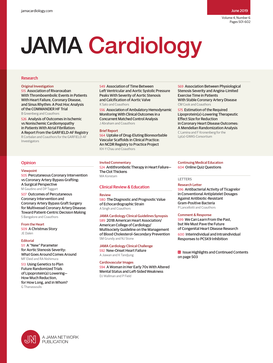Diabetes and Obesity and Treatment Effect of Early Rhythm Control vs Usual Care in Patients With Atrial Fibrillation
IF 14.1
1区 医学
Q1 CARDIAC & CARDIOVASCULAR SYSTEMS
引用次数: 0
Abstract
ImportanceThe EAST-AFNET 4 randomized clinical trial demonstrated that early rhythm control therapy added to anticoagulation therapy and therapy of concomitant conditions reduces the primary composite outcome of cardiovascular death, stroke, hospitalization because of heart failure, or acute coronary syndrome compared to usual care. However, the impact of body mass index (BMI, calculated as weight in kilograms divided by height in meters squared) and diabetes on outcomes in EAST-AFNET 4 is not known.ObjectiveTo assess the effects of BMI and diabetes on outcomes in EAST-AFNET 4.Design, Setting, and ParticipantsEAST-AFNET 4 is an international, investigator-initiated, parallel-group, open, blinded outcome assessment randomized clinical trial conducted in 11 European countries. Patients who had early atrial fibrillation (AF, diagnosed ≤1 year before enrollment) and cardiovascular conditions were eligible for inclusion. The current analysis is a prespecified secondary analysis of the EAST-AFNET 4 trial performed in the final, locked dataset assigning patients to therapy group on the basis of randomization (intention-to-treat population). EAST-AFNET 4 was conducted from June 2010 to May 2020, and this secondary analysis of the final locked data base was performed in 2024.InterventionEAST-AFNET 4 randomly assigned patients to either early rhythm control or usual care.Main Outcomes and MeasureThe primary outcome of this analysis and the EAST-AFNET 4 trial is a composite of cardiovascular death, stroke, hospitalization because of heart failure, or acute coronary syndrome.ResultsThere were 1086 patients with obesity (BMI ≥30; mean [SD] BMI 34.5 [4.2]) and 1690 patients without obesity (BMI <30; mean [SD] BMI 25.9 [2.6]). Overall mean patient age was 70 years, and 1293 patients (46.6%) were female. Patients with obesity were younger (mean [SD] age, 68 [8.6] vs 72 [7.7] years) and had more frequently nonparoxysmal AF patterns (31% vs 24%) than patients without obesity. There was no difference in mean (SD) CHA房颤患者早期心律控制与常规护理的糖尿病、肥胖及治疗效果
重要性EAST-AFNET 4随机临床试验表明,与常规治疗相比,早期心律控制治疗加在抗凝治疗和伴发疾病的治疗中可降低心血管死亡、中风、因心力衰竭住院或急性冠状动脉综合征的主要复合结局。然而,身体质量指数(BMI,以体重公斤除以身高米的平方计算)和糖尿病对EAST-AFNET 4结果的影响尚不清楚。目的评价BMI和糖尿病对EAST-AFNET患者预后的影响。设计、环境和参与者seast - afnet 4是一项国际、研究者发起、平行组、开放、盲法结果评估的随机临床试验,在11个欧洲国家进行。有早期心房颤动(AF,入组前诊断≤1年)和心血管疾病的患者符合纳入条件。当前的分析是对EAST-AFNET 4试验进行的预先指定的二次分析,该试验在最终的锁定数据集中进行,根据随机化(意向治疗人群)将患者分配到治疗组。EAST-AFNET 4于2010年6月至2020年5月进行,最终锁定数据库的二次分析于2024年进行。interoneast - afnet 4随机将患者分配到早期心律控制组或常规护理组。主要结局和测量本分析和EAST-AFNET 4试验的主要结局是心血管死亡、中风、因心力衰竭或急性冠状动脉综合征住院。结果1086例肥胖患者(BMI≥30;平均[SD] BMI 34.5[4.2])和1690例无肥胖患者(BMI <30;平均[SD] BMI 25.9[2.6])。患者总体平均年龄70岁,女性1293例(46.6%)。肥胖患者比非肥胖患者更年轻(平均[SD]年龄,68[8.6]岁对72[7.7]岁),非阵发性房颤更频繁(31%对24%)。平均(SD) CHA2DS2-VASc评分无差异(3.4 [1.3]vs 3.3[1.3])。肥胖并没有改变早期节律控制治疗对第一主要结局的影响(危险率点估计:BMI &;amp;lt;30, 0.84;Bmi≥30,0.69;相互作用P = 0.22)。糖尿病患者更年轻(平均[SD]年龄,69[8.6]岁vs 71[8.2]岁;P = .001),且CHA2DS2-VASC平均评分较高(4.06 vs 3.11;P, amp;肝移植;措施)。糖尿病与早期心律控制的治疗效果无相互作用(糖尿病:危险比[HR], 0.77;95% CI, 0.57-1.05 vs无糖尿病;HR, 0.78;95% ci, 0.64-0.96;相互作用P = 0.93)。糖尿病患者和非糖尿病患者的安全性结局无差异(351例患者中有64例[18.2%]vs 1039例患者中有167例[16.1%];相互作用P = 0.99)。结论和相关性这项EAST-AFNET 4随机临床试验的二次分析表明,早期节律控制治疗在患有和不患有糖尿病以及患有和不患有肥胖的患者中保持其有效性和安全性。临床试验注册:clinicaltrials .gov标识符:NCT01288352
本文章由计算机程序翻译,如有差异,请以英文原文为准。
求助全文
约1分钟内获得全文
求助全文
来源期刊

JAMA cardiology
Medicine-Cardiology and Cardiovascular Medicine
CiteScore
45.80
自引率
1.70%
发文量
264
期刊介绍:
JAMA Cardiology, an international peer-reviewed journal, serves as the premier publication for clinical investigators, clinicians, and trainees in cardiovascular medicine worldwide. As a member of the JAMA Network, it aligns with a consortium of peer-reviewed general medical and specialty publications.
Published online weekly, every Wednesday, and in 12 print/online issues annually, JAMA Cardiology attracts over 4.3 million annual article views and downloads. Research articles become freely accessible online 12 months post-publication without any author fees. Moreover, the online version is readily accessible to institutions in developing countries through the World Health Organization's HINARI program.
Positioned at the intersection of clinical investigation, actionable clinical science, and clinical practice, JAMA Cardiology prioritizes traditional and evolving cardiovascular medicine, alongside evidence-based health policy. It places particular emphasis on health equity, especially when grounded in original science, as a top editorial priority.
 求助内容:
求助内容: 应助结果提醒方式:
应助结果提醒方式:


